Gold: keep buying or start selling?
You need to know whether gold is good value or not before buying. But how do you value gold? Simon Caufield explains how to tell if it's a good time to buy, and when to sell.
You need to know whether gold is good value or not before buying. But how do you value gold? Simon Caufield of the True Value newsletter explains.
What do the Daily Mail, Ed Miliband, Bank of England governor Mervyn King, the TUC, and Vince Cable have in common? They all want you to believe that evil bankers caused the financial crisis. It's a tempting argument bankers do deserve a lot of the flak they're taking. But it's just too convenient.
If it were all down to the bankers, then why was this recession the worst since the Great Depression? Bankers have always been greedy. Their bonuses have always encouraged excessive risk-taking. Lending has been lax at the top of many business cycles. Yet we have not had a crisis this bad since the 1930s.
MoneyWeek
Subscribe to MoneyWeek today and get your first six magazine issues absolutely FREE

Sign up to Money Morning
Don't miss the latest investment and personal finances news, market analysis, plus money-saving tips with our free twice-daily newsletter
Don't miss the latest investment and personal finances news, market analysis, plus money-saving tips with our free twice-daily newsletter
In truth, central banks caused the crisis. Alan Greenspan messed up during his term as US Federal Reserve chairman. And Ben Bernanke and our own Mervyn King are continuing his mistakes. They don't want you to believe it was their fault. You might then start thinking about the real solution to the problem: abolish central banks; let the markets set short-term interest rates just as they already set longer-term rates.
See also
But that's not going to happen. We are stuck with King and Bernanke. So we have to invest accordingly. And right now there are two obvious investments to make to protect and grow your wealth. You won't be surprised that the first is gold. MoneyWeek has written so much about it that you might think there's nothing new to say. I think there is how would you like to know if it's still a good time to buy? And when you should sell?
I think I can answer those questions.
The second is to short government bonds. Again you won't be shocked. Who would lend money for ten years at 3% to a bunch of politicians? Gilt yields will surely rise but when? I don't know. But I do know how you can profit from rising bond yields without losing money while you wait read more on that here: How to short government bonds.
Alan Greenspan's dreadful mistakes
But first, I'll explain why you need to fear central bankers. Greenspan made three huge mistakes that caused the banking crisis. His first was to bail out hedge fund Long Term Capital Management (LTCM) in 1998. LTCM had borrowed heavily to boost its returns. When it went bust, its lenders stood to lose everything.In rescuing the lenders, Greenspan gave birth to 'Too Big To Fail'.
This changed everything for investment banks. Goldman Sachs, for example, had been a private partnership for 130 years. Partnerships are conservative organisations because their own capital is at risk. Yet Goldman went public within 12 months of the LTCM bail-out. That meant they could borrow to boost profits. And as LTCM had shown, if they borrowed big-time, the Fed would have to rescue them if they got into trouble. Goldman's lenders knew this. So they were happy to lend at ridiculous rates.
Now, investment banking is fiercely competitive. And the cardinal rule is this: if your rival is making tons of money with a particular trade, you'd better do the same if you want to keep your job. So the rest of the sector followed suit.
Mistake number two was repealing the Glass-Steagall Act. Passed in 1933, it was meant to prevent another Great Depression by separating investment and commercial banks. Of course, it was the US Congress that repealed it in 1999, but that was with Greenspan's tacit approval. Now commercial banks could trade like investment banks, using savers' money.
All that was needed now was somewhere to invest all that borrowed money.
Cue mistake number three. Greenspan kept interest rates too low for too long after the dotcom recession. Bernanke maintained the policy after he became Fed chairman in 2006. Both argued that low rates were justified because inflation was low. Bernanke called it 'The Great Moderation', and took credit for it. He should have known better. Inflation was only low if measured by consumer prices. China and India caused low inflation, China using cheap labour to cut the prices of manufactured goods and India cutting the cost of services. China also bought US government bonds in huge quantities. This kept the dollar strong so that its exports would remain cheap. This flooded the US with money, which via the banks went into the housing market.
Other inflation signs were flashing red. The economy boomed. The gold price rose after falling for 21 years. The money supply grew. House prices went through the roof. The level of debt exploded. But Greenspan and Bernanke did nothing. So bankers knew exactly where to invest all their borrowed money, safe in the knowledge that they would always be bailed out by the Fed.
It's still going on today. Bernanke and King maintain rates at record lows (are they really saying that this is still a once-in-300-years emergency?) and have been printing money to buy their own governments' debts. Meanwhile, Japan, South Korea, Taiwan, Brazil and Switzerland have all intervened in the foreign-exchange markets to weaken their currencies. The last Fed statement left no doubt that they too want a lower dollar.
This time, the money seems to be going into bonds, emerging markets and commodities. And zero interest rates are tempting investors to gear up all over again. It's an echo of 2003-2007. I think it will end badly. But I doubt that it'll be exactly the same ending as last time. In 2008, I made a lot of money in government bonds. I don't think they'll be a safe haven this time. Quite the reverse.
A value investor's guide to gold
Gold is the currency of last resort. So it should be the perfect antidote to central bankers trying to undermine paper money. But is it still worth buying today? And how do you know when to sell?
As a value investor, I like to buy assets that are priced well below their true value, then sell when they reach full value. So these questions are vital to me. My main goal is to preserve my capital, so I like to diversify my portfolio with defensive assets. Gold is one of very few options these days. But I could not bring myself to buy without a valuation. So I set about developing one. I asked myself this question: if central bank policies are the problem, what's the best way to measure how sound they are?
I decided to look at the level of interest rates relative to inflation.
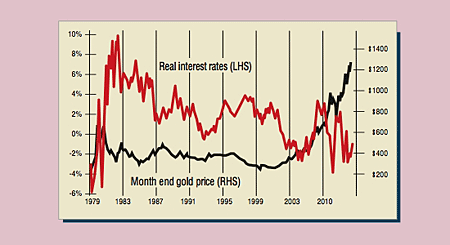
Look at the chart above. The black line shows the month-end price of gold from 1979 to today. The red line shows US real interest rates that is, the interest rate on three-month Treasury bills (US government bonds) minus annual consumer price index (CPI) inflation. Look first at the long period in the middle of the charts. For 21 years, real rates stayed above zero, except for four months in 1992 when they were very slightly negative. The gold price fell from $680 per ounce in late 1980 to $270 at the end of 2001. It fell fastest when real interest rates were at their highest.
Then consider 2002 to the present day. Real rates have been negative for most of that time. Gold has soared to $1,300. But it's not been a smooth ride. Gold stagnated in 2006 when rates were briefly positive. It also fell back in 2008 when real interest rates again briefly turned positive. Finally, look at the left-hand side. Real rates were negative for the whole of 1979. Gold exploded from $230 per ounce to $680 in January 1980.
Then there's a choppy period of six months in 1980. Real rates turned positive for three months. So gold fell below $600. Then real rates fell below zero for another three months. Gold regained $680.
When will the gold rally end?
The chart below plots the same data. The rolling 12-month change in the gold price is on the vertical axis. Real interest rates are on the horizontal. Each blue dot represents one month. The red line is the trend. Look at the bottom left-hand corner. There are no blue dots. In other words, in all 381 12-month periods, the gold price never fell when real rates were negative. Look also at the bottom right hand corner. Large falls in the gold price happen only when real rates hit 2%.
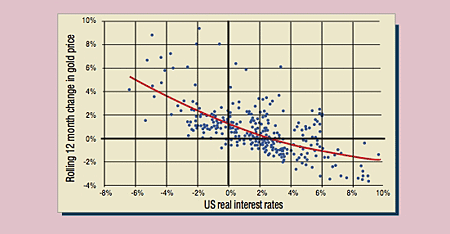
This analysis has its limitations. There are lots of points off the trend line. So the model does not explain everything that's going on. And there's no guarantee that my model built on past data will always work in the future. But it's the only way I've found to decide when to buy and sell gold. And what it tells me is that the gold price rises when US real interest rates are negative. Today, they are 1% (interest rates are close to zero and US inflation is 1%). So you can still buy gold here. But watch the Fed like a hawk. If Bernanke lifts interest rates above the rate of inflation, that will be your signal to dump gold.
The best way to buy gold
My favoured way to buy gold is via the ETFS Physical Gold £ ETF (LSE: PHGP). It owns gold bars stored in a secure HSBC-owned vault. Each bar has a unique serial number and is allocated to its owner, so there's little counter-party risk.
Simon Caufield writes the True Value newsletter, which sets out his plan to grow your wealth at an average of 15% a year. True Value is open to new subscribers, but only until 10 Dec. Visit www.moneyweek.com/tv.aspx ; or call 020-7633 3780. (True Value is a regulated product issued by MoneyWeek Ltd.)
This article was originally published in MoneyWeek magazine issue number 509 on 22 October 2010, and was available exclusively to magazine subscribers. To read more articles like this, ensure you don't miss a thing, and get instant access to all our premium content, subscribe to MoneyWeek magazine now and get your first three issues free.
Get the latest financial news, insights and expert analysis from our award-winning MoneyWeek team, to help you understand what really matters when it comes to your finances.
Simon Caufield started out as an engineer and has an MA in engineering from Cambridge. This was followed by an MBA from the London Business School.
After graduating, Simon worked his way up to become a Management Consultant for banks and insurance companies. This gave him the chance to see the city from the inside.
In 2001, Simon started his own company to develop software designed to price banking services, such as loans and deposits. After growing the company to 100 employees, he went on to sell this in 2007, looking for his next challenge.
Also during 2007, Simon ‘sacked’ his fund managers and took complete control over his investments. Now he devotes all his time to investing and is an angel investor to help start-up companies. He has built up a reputable 20 years in the industry.
Simon writes his own investment newsletter – True Value. This follows the strategy he established in 2007 and is based on assets that are priced way below their true value. He scours the worldwide markets for equities, bonds and alternative investments to find opportunities that fit his conservative and contrarian approach.
-
 ‘Why I have ditched my Help to Buy ISA for cash savings and the stock market’
‘Why I have ditched my Help to Buy ISA for cash savings and the stock market’Without the 25% bonus, my Help to Buy ISA is effectively redundant, says MoneyWeek writer Sam Walker.
-
 Is your inheritance tax allowance cut if you sell to downsize or sell your home to pay for care?
Is your inheritance tax allowance cut if you sell to downsize or sell your home to pay for care?Downsizing relief is a little-known benefit that could save your loved ones tens of thousands of pounds in inheritance tax after you’ve died.
-
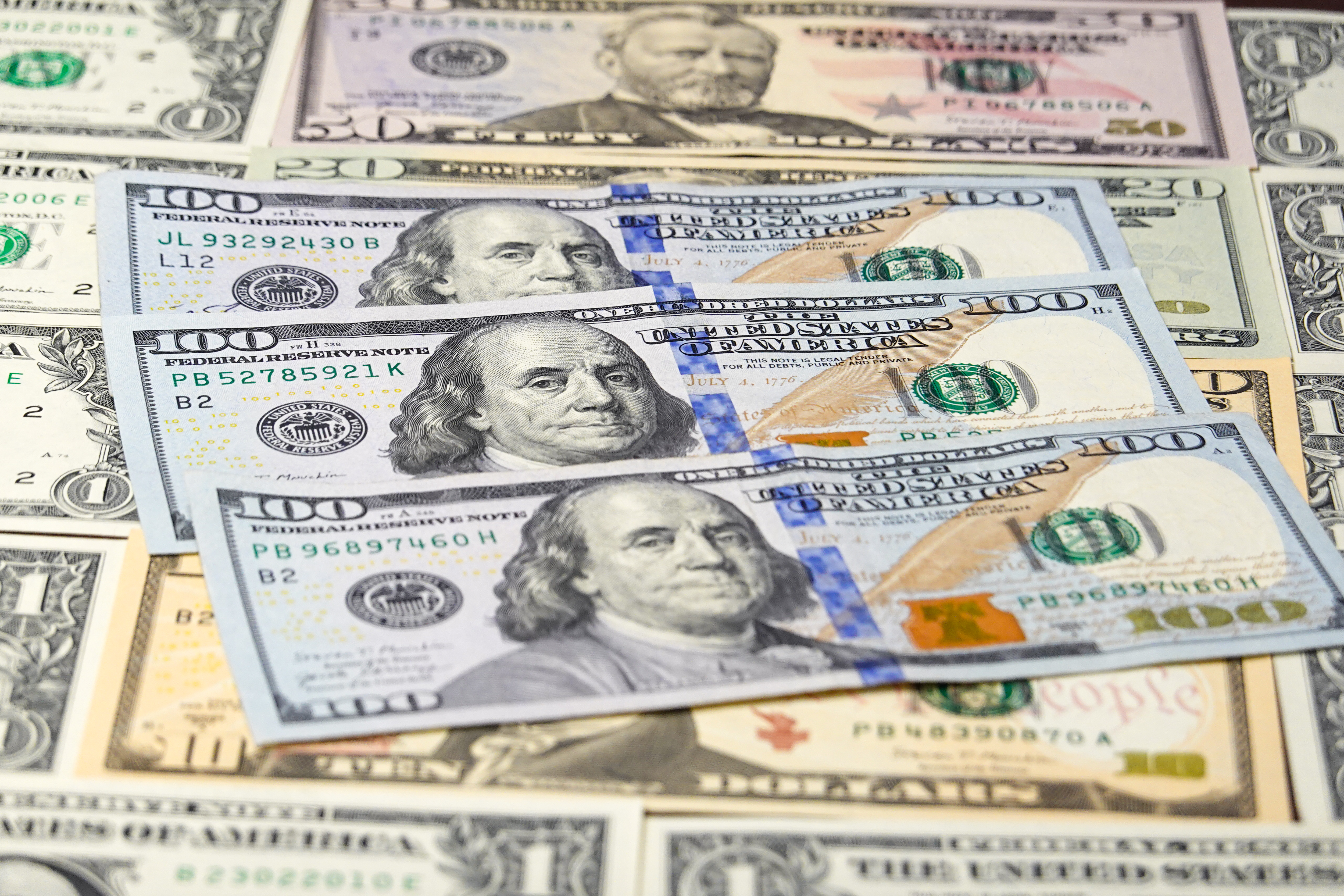 The challenge with currency hedging
The challenge with currency hedgingA weaker dollar will make currency hedges more appealing, but volatile rates may complicate the results
-
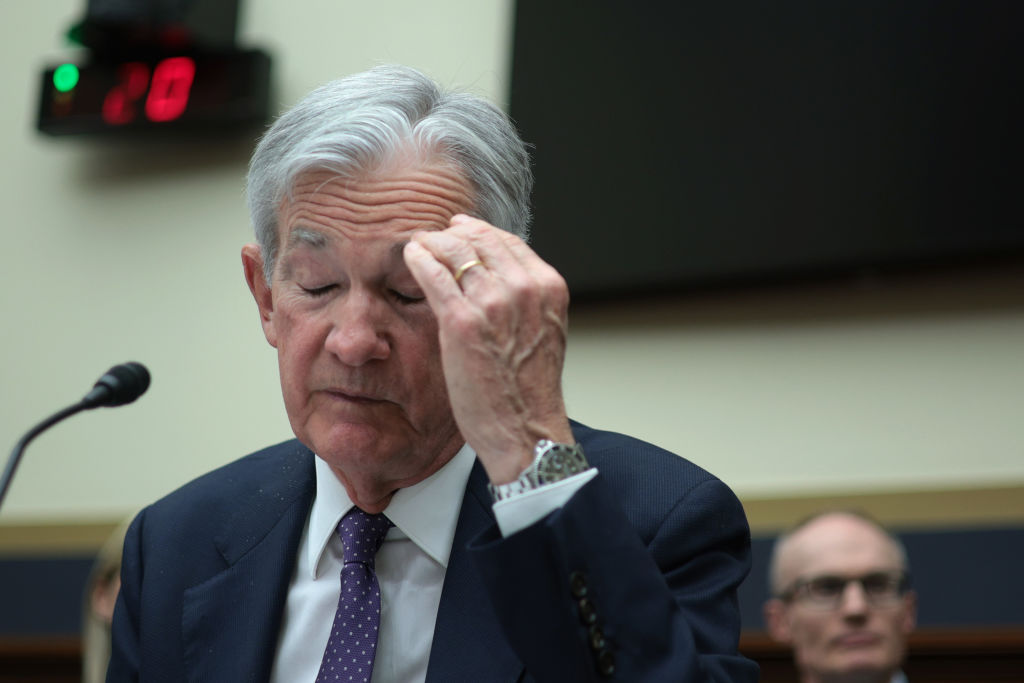 Can Donald Trump fire Jay Powell – and what do his threats mean for investors?
Can Donald Trump fire Jay Powell – and what do his threats mean for investors?Donald Trump has been vocal in his criticism of Jerome "Jay" Powell, chairman of the Federal Reserve. What do his threats to fire him mean for markets and investors?
-
 Freetrade’s new easy-access funds aim to beat top savings rates
Freetrade’s new easy-access funds aim to beat top savings ratesFreetrade has launched an easy-access exchange traded fund (ETF) range - here’s how the ETFs work and how they compare to the savings market
-
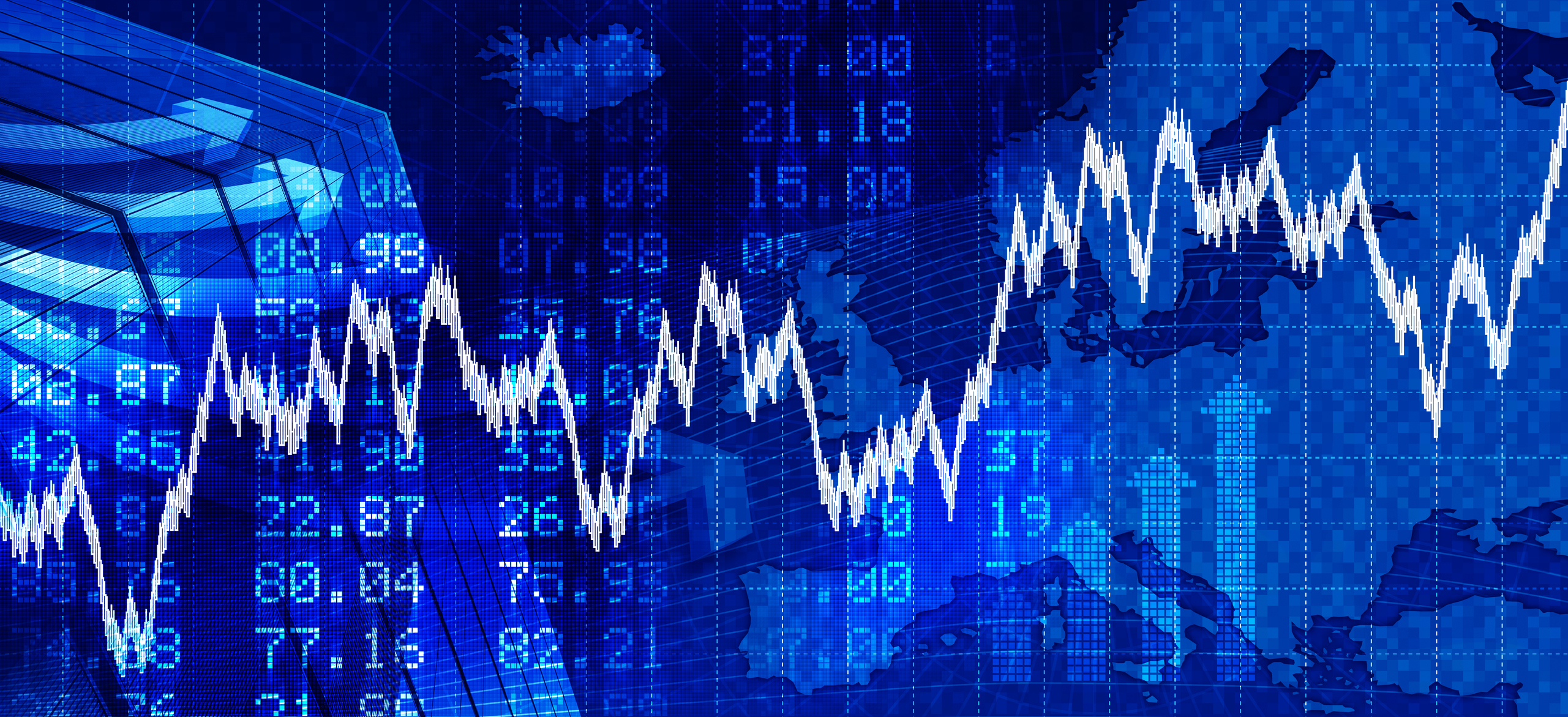 Go for value stocks to insure your portfolio against shocks, says James Montier
Go for value stocks to insure your portfolio against shocks, says James MontierInterview James Montier, at investment management group GMO, discusses value stocks and slow-burn Minsky moments with MoneyWeek.
-
 Diagnosing cancer more deftly will pay dividends
Diagnosing cancer more deftly will pay dividendsGiven that 50% of Britons will develop cancer during their lifetimes, we need to get better at detecting it, says Matthew Partridge. These firms are leading the technological charge.
-
 Where do we go from here?
Where do we go from here?Features A new series of interviews from MoneyWeek
-
 As China reopens, why pick an income strategy?
As China reopens, why pick an income strategy?Advertisement Feature Yoojeong Oh, Investment Manager, abrdn Asian Income Fund Limited
-
 Income in the USA
Income in the USAAdvertisement Feature Fran Radano, manager on The North American Income Trust